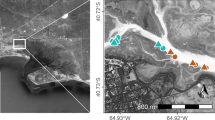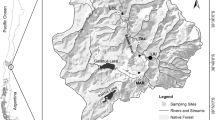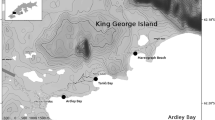Abstract
The green macroalga Caulerpa filiformis has been spreading on shallow soft sediment habitats along the Peruvian coast, colonizing previously unvegetated sediments to create monospecific meadows. We examined the nature of the impact of C. filiformis meadows on the density, taxonomic richness and assemblage structure of epifaunal and infaunal benthic macroinvertebrates. Specifically, we tested whether the spread of C. filiformis has resulted in different macroinvertebrate assemblages than those formed by the dominant native macroalgae (i.e., Rhodymenia spp.) and unvegetated sediments. Surveys were undertaken in two bays in each of two locations, in central and southern Peru, during winter 2017 and summer 2018. In general, our results show that macroinvertebrate assemblages were similar across all three habitats, although there were some differences, related to location and time, but with no clear patterns observed. Taxonomic richness and density was generally higher in the vegetated habitats than the unvegetated habitat, and where there were differences between the two vegetated habitats there was no consistent pattern of which habitat supported the highest richness or density. Given invading C. filiformis is primarily colonizing unvegetated habitats it would appear that this species is creating a new niche which supports similar assemblages, but higher taxonomic richness and density than unvegetated habitats. While our study suggests that C. filiformis is having a limited ecological impact we recommend that actions be put in place to limit the spread of this invasive species at the same time as increasing monitoring of the ecological impacts of this species as lags in the ecological impacts of invasive species are common.





Similar content being viewed by others
Data Availability
Raw data will be made openly available following publication. All data will be made available in Dryad following publication.
References
Abdullah MI, Fredriksen S, Christie H (2017) The impact of the kelp (Laminaria hyperborea) forest on the organic matter content in sediment of the west coast of Norway. Mar Biol Res 13:151–160. https://doi.org/10.1080/17451000.2016.1240369
Acleto C (1973) Las Algas Marinas del Perú. Soc Per Bot 6:1–164
Airoldi L, Beck M (2007) Loss, status and trends for coastal marine habitats of Europe. Oceanogr Mar Biol 45:345–405. http://www.vliz.be/en/imis?refid=111481. Accessed 15 May 2020
Anderson M, Gorley R, Clarke K (2008) PERMANOVA + for PRIMER: Guide to software and statistical methods PRIMER-E: Plymouth, UK
Box A, Martin D, Deudero S (2010) Changes in seagrass polychaete assemblages after invasion by Caulerpa racemosa var. cylindracea (Chlorophyta: Caulerpales): community structure, trophic guilds and taxonomic distinctness. Sci Mar 74:317–329. https://doi.org/10.3989/scimar.2010.74n2317
Bulleri F, Alestra T, Ceccherelli G, Tamburello L, Pinna S, Sechi N, Benedetti-Cecchi L (2011) Determinants of Caulerpa racemosa distribution in the north-western Mediterranean. Mar Ecol Prog Ser 431:55–67. https://doi.org/10.3354/meps09137
Camus PA (2005) Introducción de especies en ambientes marinos chilenos: no solo exóticas, no siempre evidentes. Rev Chil de Hist Nat 78:155–159. https://doi.org/10.4067/S0716-078X2005000100011
Carey MP, Sanderson BL, Barnas KA, Olden JD (2012) Native invaders—challenges for science, management, policy, and society. Front Ecol Environ 10:373–381. https://doi.org/10.1890/110060
Castilla JC, Neill PE (2009) Marine bioinvasions in the southeastern Pacific: status, ecology, economic impacts, conservation and management. In: Rilov G, Crooks JA (eds) Biological invasions in marine ecosystems. Springer, Berlin, pp 439–457
Ceccherelli G, Piazzi L, Balata D (2002) Spread of introduced Caulerpa species in macroalgal habitats. J Exp Mar Biol Ecol 280:1–11. https://doi.org/10.1016/S0022-0981(02)00336-2
Ceccherelli G, Pinna S, Cusseddu V, Bulleri F (2014) The role of disturbance in promoting the spread of the invasive seaweed Caulerpa racemosa in seagrass meadows. Biol Invasions 16(12):2737–2745
Cevik C, Cavas L, Mavruk LS, Derici O, Cevik F (2012) Macrobenthic assemblages of newly introduced Caulerpa taxifolia from the Eastern Mediterranean coast of Turkey. Biol Invasions 14:499–501. https://doi.org/10.1007/s10530-011-0095-7
Coleman MA, Kelaher BP, Steinberg PD, Millar A (2008) Absence of a large brown macroalga on urbanized rocky reefs around Sydney, Australia, and evidence for historical decline. J Phycol 44:897–901. https://doi.org/10.1111/j.1529-8817.2008.00541.x
Connell SD, Russell BD, Turner D, Shepherd SA, Kildea T, Miller D, Airoldi L, Cheshire A (2008) Recovering a lost baseline: missing kelp forests from a metropolitan coast. Mar Ecol Prog Ser 360:63–72. https://doi.org/10.3354/meps07526
Coppejans E, Leliaert F, Verbruggen H (2005) Green algae. Chlorophyceae. In: De Clerck O, Bolton JJ, Anderson RJ, Coppejans E (eds) Guide to the seaweeds of KwaZulu-Natal. Scripta Botanica, Belgica, pp 39–93
Crooks JA (2002) Characterizing ecosystem-level consequences of biological invasions: the role of ecosystem engineers. Oikos 97:153–166. https://doi.org/10.1034/j.1600-0706.2002.970201.x
Crooks JA (2005) Lag times and exotic species: the ecology and management of biological invasions in slow-motion. Ecoscience. https://doi.org/10.2980/i1195-6860-12-3-316.1. 12:316 – 329
Cvitkovic I, Despalatovic M, Žuljevic A, Matijevic S, Bogner D, Lušic J, Travizi A (2017) Structure of epibiontic and sediment meiofauna in the area invaded by invasive alga Caulerpa taxifolia. Mar Biol 164:4. https://doi.org/10.1007/s00227-016-3034-4
Dijkstra JA, Harris LG, Mello K, Litterer A, Wells C, Ware C (2017) Invasive seaweeds transform habitat structure and increase biodiversity of associated species. J Ecol 105(6):1668–1678. https://doi.org/10.1111/1365-2745.12775
Edwards M, Konar B, Kim JH, Gabara S, Sullaway G, McHugh T, Spector M, Small S (2020) Marine deforestation leads to widespread loss of ecosystem function. PLoS ONE 15(3):e0226173. https://doi.org/10.1371/journal.pone.0226173
Epstein G, Smale DA (2017) Undaria pinnatifida: a case study to highlight challenges in marine invasion ecology and management. Ecol Evol 7:8624–8642. https://doi.org/10.1002/ece3.3430
Epstein G, Hawkins SJ, Smale DA (2019a) Identifying niche and fitness dissimilarities in invaded marine macroalgal canopies within the context of contemporary coexistence theory. Sci Rep 9:8816. https://doi.org/10.1038/s41598-019-45388-5
Epstein G, Foggo A, Smale DA (2019b) Inconspicuous impacts: widespread marine invader causes subtle but significant changes in native macroalgal assemblages. Ecosphere 10:e02814. https://doi.org/10.1002/ecs2.2814
Fernández RG, Hooker Y (2020) Revisiting the diversity and distribution of the ophiuroids (Echinodermata: Ophiuroidea) from Peru. Zootaxa 4766(4):539–556. https://doi.org/10.11646/zootaxa.4766.4.2
Filbee-Dexter K, Wernberg T (2018) Rise of turfs: a new battlefront for globally declining kelp forests. Bioscience 68:64–76. https://doi.org/10.1093/biosci/bix147
Gallucci F, Hutchings P, Gribben P, Fonseca G (2012) Habitat alteration and community-level effects of an invasive ecosystem engineer: a case study along the coast of NSW, Australia. Mar Ecol Prog Ser 449:95–108. https://doi.org/10.3354/meps09547
Glasby TM (2013) Caulerpa taxifolia in seagrass meadows: killer or opportunistic weed? Biol Invasions 15:1017–1035. https://doi.org/10.1007/s10530-012-0347-1
Glasby TM, Gibson PT, Kay S (2005) Tolerance of the invasive marine alga Caulerpa taxifolia to burial by sediment. Aquat Bot 82:71–81. https://doi.org/10.1016/j.aquabot.2005.02.004
Glasby T, Gibson P, West G, Davies P, Voerman S (2015) Range and habitat associations of the native macroalga Caulerpa filiformis in New South Wales, Australia. Mar Freshw Res 66:1018–1026. https://doi.org/10.1071/MF14282
Heiser S, Hall-Spencer JM, Hiscock K (2014) Assessing the extent of establishment of Undaria pinnatifida in Plymouth Sound Special Area of Conservation, UK. Mar Biodivers Rec 7:e93. https://doi.org/10.1017/S1755267214000608
Howe MA (1914) The marine algae of Peru. Press of the new era Print. Company
Kluger LC, Taylor MH, Rivera EB, Silva E, Wolff M (2016) Assessing the ecosystem impact of scallop bottom culture through a community analysis and trophic modelling approach. Mar Ecol Prog Ser 547:121–135. https://doi.org/10.3354/meps11652
Krumhansl KA, Okamoto D, Rassweiler A et al (2016) Global patterns of kelp forest change over the past half-century. PNAS 113:13785–13790. https://doi.org/10.1073/pnas.1606102113
Lanham BS, Gribben PE, Poore AG (2015) Beyond the border: effects of an expanding algal habitat on the fauna of neighbouring habitats. Mar Environ Res 106:10–18. https://doi.org/10.1016/j.marenvres.2015.02.006
Lubchenco J, Olson A, Brubaker L et al (1991) The sustainable biosphere initiative—an ecological research agenda—a report from the Ecological Society of America. Ecology 72:371–412. https://doi.org/10.2307/2937183
Maidanou M, Koulouri P, Arvanitidis C, Koutsoubas D, Dounas C (2017) Macrobenthic assemblage structure associated with a Caulerpa prolifera meadow in the eastern Mediterranean Sea (Elounda Bay, Crete Island). Reg Stud Mar Sci 14:1–14. https://doi.org/10.1016/j.rsma.2017.04.004
Mendo J, Wolff M, Carbajal W, Gonzáles I, Badjeck M (2008) Manejo y explotación de los principales bancos naturales de concha de abanico (Argopecten purpuratus) en la costa Peruana. En Lovatelli A, Farías A, Uriarte I (ed) Taller regional de la FAO sobre el Estado Actual del Cultivo y Manejo de Moluscos Bivalvos y su Proyección Futura: Factores que Afectan su Sustentabilidad en América Latina. Actas de Pesca de la FAO, Roma, pp 101–114
Montefalcone M, Morri C, Parravicini V, Bianchi C (2015) A tale of two invaders: divergent spreading kinetics of the alien green algae Caulerpa taxifolia and Caulerpa cylindracea. Biol Invasions 17:2717–2728. https://doi.org/10.1007/s10530-015-0908-1
Neira C, Levin LA, Grosholz ED (2005) Benthic macrofaunal communities of three sites in San Francisco Bay invaded by hybrid Spartina, with comparison to uninvaded habitats. Mar Ecol Prog Ser 292:111–126. https://doi.org/10.3354/meps292111
Pacheco AS, Uribe RA, Thiel M, Oliva ME, Riascos JM (2013) Dispersal of post-larval macrobenthos in subtidal sedimentary habitats: Roles of vertical diel migration, water column, bedload transport and biological traits’ expression. J Sea Res 77:79–92. https://doi.org/10.1016/j.seares.2012.10.004
Piazzi L, Ceccherelli G, Balata D, Cinelli F (2003) Early patterns of Caulerpa racemosa recovery in the Mediterranean Sea: the influence of algal turfs. J Mar Biolog Assoc UK 83(1):27–29. https://doi.org/10.1017/S0025315403006751h
Piazzi L, Balata D, Ceccherelli G, Cinelli F (2005) Interactive effect of sedimentation and Caulerpa racemosa var. cylindracea invasion on macroalgal assemblages in the Mediterranean Sea. Estuar Coast Shelf Sci 64:467–474. https://doi.org/10.1016/j.ecss.2005.03.010
Piazzi L, Balata D, Foresi L, Cristaudo C, Cinelli F (2007) Sediment as a constituent of Mediterranean benthic communities dominated by Caulerpa racemosa var. cylindracea. Sci Mar 71:129–135. https://doi.org/10.3989/scimar.2007.71n1129
Pillmann A, Woolcott G, Olsen J, Stam W, King R (1997) Inter- and intraspecific genetic variation in Caulerpa (Chlorophyta) based on nuclear rDNA ITS sequences. Eur J Phycol 32(4):379–386. https://doi.org/10.1080/09670269710001737319
Posey MH (1988) Community changes associated with the spread of an introduced seagrass, Zostera japonica. Ecology 69:974–983. https://doi.org/10.2307/1941252
Pusceddu A, Fraschetti S, Scopa M, Rizzo L, Danovaro R (2016) Meiofauna communities, nematode diversity and C degradation rates in seagrass (Posidonia oceanica L.) and unvegetated sediments invaded by the algae Caulerpa cylindracea (Sonder). Mar Environ Res 119:88–99. https://doi.org/10.1016/j.marenvres.2016.05.015
Schaal G, Riera P, Leroux C (2009) Trophic significance of the kelp Laminaria digitata (Lamour.) for the associated food web: a between-sites comparison. Estuar Coast Shelf Sci 85:565–572. https://doi.org/10.1016/j.ecss.2009.09.027
Shelamoff V, Layton C, Tatsumi M, Cameron MJ, Edgar GJ, Wright JT, Johnson CR (2019) Kelp patch size and density influence secondary productivity and diversity of epifauna. Oikos 129(3):331–345. https://doi.org/10.1111/oik.06585
South PM, Floerl O, Forrest BM, Thomsen MS (2017) A review of three decades of research on the invasive kelp Undaria pinnatifida in Australasia: An assessment of its success, impacts and status as one of the world’s worst invaders. Mar Environ Res 131:243–257. https://doi.org/10.1016/j.marenvres.2017.09.015
Steneck RS, Graham MH, Bourque BJ, Corbett D, Erlandson JM, Estes JA, Tegner MJ (2002) Kelp forest ecosystems: biodiversity, stability, resilience and future. Environ Conserv 29(4):436–459. https://doi.org/10.1017/S0376892902000322
Suárez–Jiménez R, Hepburn CD, Hyndes GA, McLeod RJ, Taylor RB, Hurd CL (2017) Importance of the invasive macroalga Undaria pinnatifida as trophic subsidy for a beach consumer. Mar Biol 164:113. https://doi.org/10.1007/s00227-017-3140-y
Tasso V, El Haddad M, Assadi C, Canales R, Aguirre L, Vélez-Zuazo X (2018) Macrobenthic fauna from an upwelling coastal area of Peru (Warm Temperate South-eastern Pacific province -Humboldtian ecoregion). Diversity 6:e28937. https://doi.org/10.3897/BDJ.6.e28937
Teagle H, Hawkins SJ, Moore PJ, Smale DA (2016) The role of kelp species as biogenic habitat formers in coastal marine ecosystems. J Exp Mar Biol Ecol 492:81–98. https://doi.org/10.1016/j.jembe.2017.01.017
Underwood AJ (1991) Beyond BACI: experimental designs for detecting human environmental impacts on temporal variations in natural populations. Aust J Mar Freshw Res 42:569–587. https://doi.org/10.1071/MF9910569
Uribe RA, Nakamura K, Indacochea A, Pacheco AS, Hooker Y, Schrödl M (2013) A review on the diversity and distribution of opisthobranch gastropods from Peru, with the addition of three new records. Spixiana 36(1):43–60. https://pfeil-verlag.de/wp-content/uploads/2015/05/spix36_1_05.pdf. Accessed 20 May 2020
Uribe RA, Ortiz M, Macaya E, Pacheco AS (2015) Successional patterns of hard-bottom macrobenthic communities at kelp bed (Lessonia trabeculata) and barren ground sublittoral systems. J Exp Mar Biol Ecol 472:180–188. https://doi.org/10.1016/j.jembe.2015.08.002
Valentine JP, Johnson CR (2003) Establishment of the introduced kelp Undaria pinnatifida in Tasmania depends on disturbance to native algal assemblages. J Exp Mar Biol Ecol 295:63–90. https://doi.org/10.1016/S0022-0981(03)00272-7
Valéry L, Fritz H, Lefeuvre JC, Simberloff D (2009) Invasive species can also be native…. Trends Ecol Evol 24:585. https://doi.org/10.1016/j.tree.2009.07.003
Villaseñor-Parada C, Pauchard A, Ramírez ME, Macaya EC (2018) Macroalgas exóticas en la costa de Chile: patrones espaciales y temporales en el proceso de invasión. Lat Am J Aquat Res 46:147–165. https://doi.org/10.3856/vol46-issue1-fulltext-15
Voerman SE, Glasby TM, Gladstone W, Gribben PE (2017) Habitat associations of an expanding native alga. Mar Environ Res 131:205–214. https://doi.org/10.1016/j.marenvres.2017.09.019
Voerman SE, Gribben PE, Glasby TM (2021) Positive and negative species interactions shape recruitment patterns of a range expanding native alga. Front Mar Sci 8:236
Walsh JR, Carpenter SR, Vander Zanden MJ (2016) Invasive species triggers a massive loss of ecosystem services through a trophic cascade. Proc Natl Acad Sci 113(15):4081–4085. https://doi.org/10.1073/pnas.1600366113
Watanuki A, Aota T, Otsuka E, Kawai T, Iwahashi Y, Kuwahara H, Fujita D (2010) Restoration of kelp beds on an urchin barren: removal of sea urchins by citizen divers in southwestern Hokkaido. Bull Fish Res Agen 32:83–87. https://www.cabdirect.org/cabdirect/abstract/20113186284. Accessed 15 July 2021
Williams SL, Smith JE (2007) A global review of the distribution, taxonomy, and impacts of introduced seaweeds. Annu Rev Ecol Evol Syst 38:327–359. https://doi.org/10.1146/annurev.ecolsys.38.091206.095543
Zhang D, Glasby TM, Ralph PJ, Gribben PE (2014) Mechanisms Influencing the Spread of a Native Marine Alga. PLoS ONE 9(4):e94647. https://doi.org/10.1371/journal.pone.0094647
Acknowledgements
This paper is the result of SA Master Thesis. We especially thank to Tim Glasby for his comments during an early version of the manuscript. The authors thank the student members of the ECOMAC research group of the Universidad Nacional Mayor de San Marcos (UNMSM) for assistance in the dive activities, sorting and identification of organisms.
Funding
This project was funded by the Programa de Promoción de Tesis de Postgrado para Docentes de la UNMSM, project code B17100215b. PJM was funded by a NERC-Newton Fund grant NE/S011692/1. RUA was funded by the National Council of Science, Technology and Technological Innovation (FONDECYT) - No E041-2018-01-NERC, Convenio/Contrato N°028-2019-FONDECYT.
Author information
Authors and Affiliations
Contributions
SA contributed to the data collection and samples analysis, PJM contributed to the analysis, wrote the original draft and review the final manuscript, RUA contributed to the study conception, the data collection, analysis, wrote the original draft and review the final manuscript. All authors read and approved the manuscript.
Corresponding author
Ethics declarations
Conflict of interest
The authors declare that they have no conflict of interest.
Additional information
Publisher’s Note
Springer Nature remains neutral with regard to jurisdictional claims in published maps and institutional affiliations.
Electronic supplementary material
Below is the link to the electronic supplementary material.
Rights and permissions
About this article
Cite this article
Aguilar, S., Moore, P.J. & Uribe, R.A. Habitat formed by the invasive macroalga Caulerpa filiformis (Suhr) Hering (Caulerpales, Chlorophyta) alters benthic macroinvertebrate assemblages in Peru. Biol Invasions 24, 3305–3319 (2022). https://doi.org/10.1007/s10530-022-02847-x
Received:
Accepted:
Published:
Issue Date:
DOI: https://doi.org/10.1007/s10530-022-02847-x




